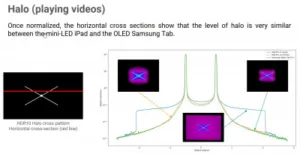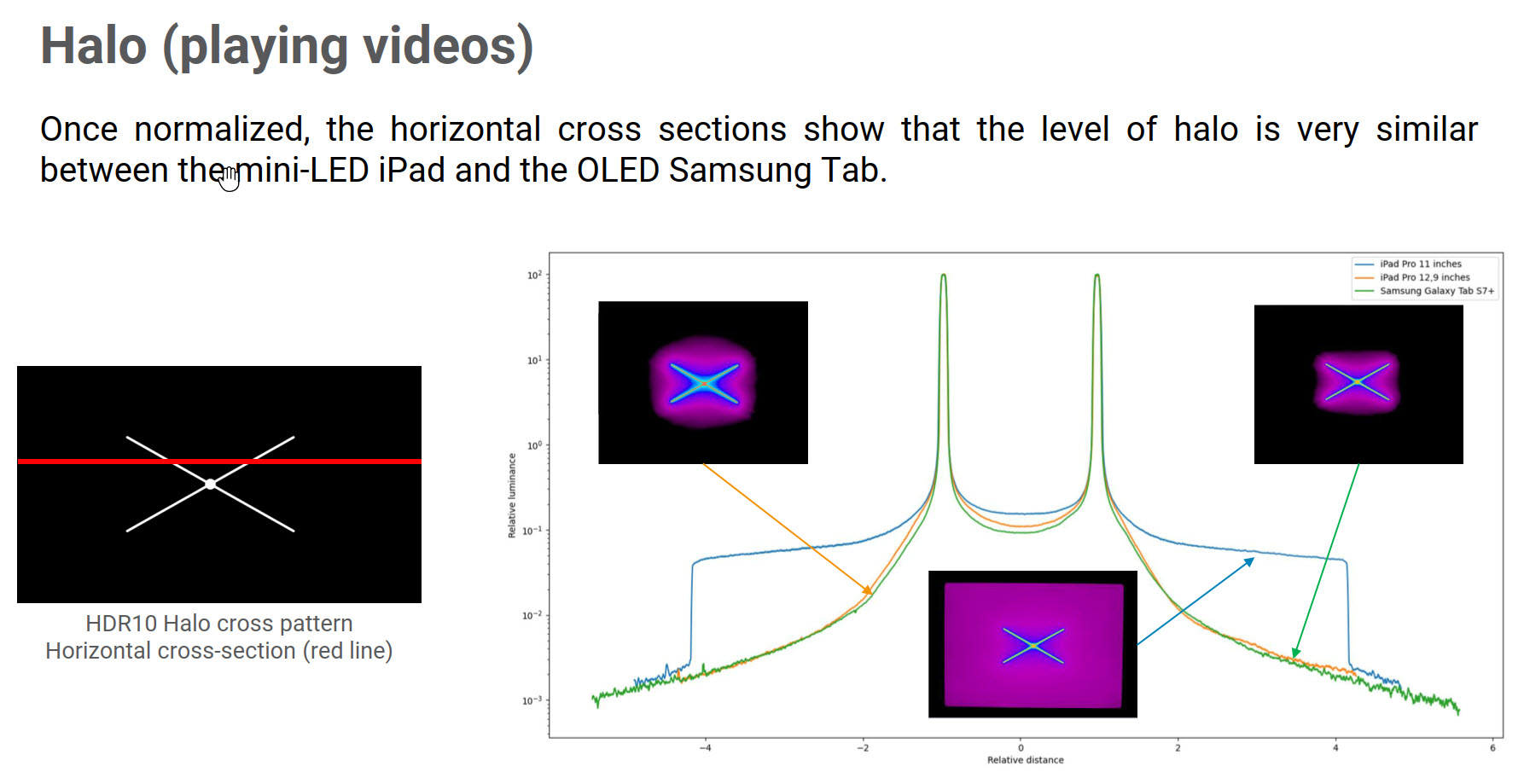LCDs backlit with miniLED LCDs are a growing segment of the premium markets for tablets, notebooks, monitors and TVs. We’ve written extensively about the engineering that is inside the Apple miniLED displays that are in the firm’s IT products in the these categories. In particular, we were able to dig into the detail of the Pro Display XDR that was launched in 2019. (Apple Explains the Pro XDR Monitor).
About the Testers
So I was particularly pleased to hear that DXOMARK, a device testing service supplier, had done a detailed analysis of the 12.9″ miniLED display that is in the iPad Pro and compared it to the regular edge-lit LCD in the 11″ iPad Pro. DXOMARK has a well established team of image quality engineers that, a long time ago, came out of the DxO Optics team. I have been a user of that software for at least eight years to make the most of RAW images from my digital camera. The firm carefully analysed the performance of many, many cameras and lenses and the software automatically corrects the image to compensate for imaging issues.
Anyway, the testing side has been doing its own work for a long time and in 2008 created dxomark.com to share in-depth camera reviews. In 2017, the business spun off from DxO Labs and is based in Boulogne-Billancourt, in Paris, just a short walk from what used to be the HQ of Thomson’s TV business, and TTE it’s ill-fated venture with TCL. That suggests plenty of understanding of video image quality in the area!
The scope of the testing was comprehensive and covered power and perceptual performance along with traditional display measurements.
I first wrote this article intending it to cover all the aspects of the test but when I got to the end, one area stood out as particularly interesting so I thought I’d dig deeper into it.
Halos
A particularly fascinating part of the test was that DXOMARK compared haloing not only for the two iPads, but bringing in an OLED-based tablet, the Samsung Galaxy Tab S7+ for comparison. Haloing, that is to say patches of the screen that have been lit up by an LED, but that are bigger than the bright detail that triggered the boost, is considered to be the key image quality downside of miniLED (cost is the other significant non-image disadvantage). The performance of the 12.9″ miniLED LCD was very, very close to the OLED which was something of a surprise to me. You can pretty well summarise every comparison of miniLED displays (such as TCL’s or Samsung’s QD miniLED TVs) against OLEDs (such as LG’s or Sony’s OLED TVs) as saying that miniLED provides better peak brightness but OLED has less haloing.
The result from the DXOMARK test showed that the haloing on the Apple 12.9″ miniLED LCD iPad Pro was almost exactly the same as on the Samsung OLED tablet, but both of those were very different from the 11″ iPad. How could that be?
To get the results as close as they are, I think we have to assume that both the 12.9″ must be particularly good, while the OLED is perhaps not as good as you might think.
In the case of the Apple iPad, it really is very good. At the end of 2020, we dug out details of the backlight used in the Pro Display XDR monitor. I won’t dig into the details here, you can check it here. What it highlights is the huge amount of optical and thermal engineering that went into creating the monitor and I suspect that the knowledge that Apple gained from that development helped with the design of the iPad.
I happen to have the iPad Pro 12.9″ and it would be fair to say that I’m very picky about image quality. I don’t use the iPad a huge amount, but when I do, I am continually impressed with the display quality and lack of things I can be picky about! I was very nervous when I got it as my last tablet used an OLED, my TV is an OLED and my smartphone is an OLED (you might spot a pattern here!).
I dug out my OLED Tablet
So, I dug out my oldish OLED tablet, which still has a very good display as it hasn’t been much used, and saw that there was some haloing. I’m pretty sure that it is caused by internal reflections from the bright OLED in the glass around the bright pixels and subjectively, there was more haloing on my tablet OLED than on the miniLED display on the iPad. Given that the OLED display is significantly older, it’s likely that recent ones are better, but it seems perfectly feasible that the OLED and miniLED are now about the same.
So what about the third display – the 11″ iPad? The 11″ uses an edge-lit backlight. That showed very sharp edges and a large area around bright highlights. My conclusion on this is that the 11″ uses zonal backlighting with a light guide plate that it steering the light to different parts of the display area. There can only be as many of those regions as there are LEDs around the edge of the display, at most.
However the 11″ looks as though it has big backlight zones. The way that the edges drop in brightness suggests that the edgelit display is using optics to guide the light from different LEDs to different parts of the screen. It was a long way from the OLED and the miniLED.
The result that the miniLED and OLED were so close was a surprise to me and showed the value of this kind of detailed objective testing.
The 12.9″ Shines in HDR
Turning to other aspects of the displays, the big deal with the 12.9″ is the extra contrast and luminance that the 12.9″ display can produce, which really comes into play when HDR content is being shown. In SDR modes, which are created to be viewed at lower brightness, the two displays are very similar with even the non-miniLED 11″ iPad producing over 600 cd/m² (with a 10% window). In HDR, though, things look very different and the 12.9″ produces more light at every level and 1,000 cd/m² more at the high end of the range.
Because of the different ways that the backlights work, the results between the two displays are very different, depending on the pattern used to show a particular average APL. For example, look at this result from the tests.
 Both patterns produce an APL of 5%, but with more widespread smaller dots, the advantage of the miniLED backlight is reduced.
Both patterns produce an APL of 5%, but with more widespread smaller dots, the advantage of the miniLED backlight is reduced.
As you would expect, when viewing photo images which are not shown with HDR, there is little difference in contrast performance, but in video that changes and if you have contrasty content where the miniLEDs can really come into their own, the 12.9″ really excels in contrast, reaching over 3,500:1 in HDR video, while the 11″ limits at less than 2,500:1. With less influence from the miniLEDs, the 12.9″ is just over 2,000:1 while the 11″ is at 1,500:1. The numbers for even the 11″ iPad Pro are very good for an IPS LCD which are often limited to 1,000:1.
(It made me wonder if Apple had been an early client for LG Display’s IPS Black technology. Over the years, LG & Apple have often collaborated, with Apple having an exclusive access period to a new technology. Further, LG has been very reluctant to share any information about the IPS Black technology, which is unusual for the firm – editor).
In both displays, in high ambient light the black level rises to reduce the maximum contrast, but the 12.9″ miniLED does a bit better (at 300 lux).
Perceptually, in low light, the extra brightness of the 12.9″ model is an advantage with low level tones more visible as a result. The higher brightness results in more power consumption in the miniLED display, and when displaying bright content, such as a 250cd/m² 100% APL image on both, when the 12.9″ uses more power. However, like PDPs or OLEDs, in video with a low APL, many of the LEDs will power down, so the overall consumption gets closer.
Colour Gamuts
In terms of colour gamut viewing photos, the 12.9″ has a very slightly wider gamut than the 11″ in sRGB and P3 modes, but they are very close. In terms of JNCDs and colour accuracy when viewing photos, they are again similar, although the 11″ has slightly less error in foliage and in purple. However, with an average of 1, the colour accuracy on both is very good.
Brightness uniformity is slightly better on the miniLED display, but they are close. Apple doesn’t say if it has any special technology to optimise uniformity, but the result is pretty good, although non-uniformity is more obvious at low grey levels. Colour uniformity is excellent on both displays and are almost imperceptible.
Finally, the firm found that there is some flicker in the 12.9″ does produce flicker at 480Hz, whereas the 11″ device does not. I was surprised to see that any flicker at that high rate might be visible. I queried this with DXO and the firm said
“Additionally, it seems that this kind of sensitivity is variable among individuals. Unfortunately, we have a hard time finding papers covering this topic. There are few researches and they are rarely directly associated to our scope. So for now, we sail in kind of a gray zone with people complaining but no medical proof.”
I’m grateful to DXOMARK for giving me access to a report that would normally only be available to customers. I’m planning to follow up this article with another, shortly, to look at some work that the firm is doing in collaboration with Yole Développement. (BR)


